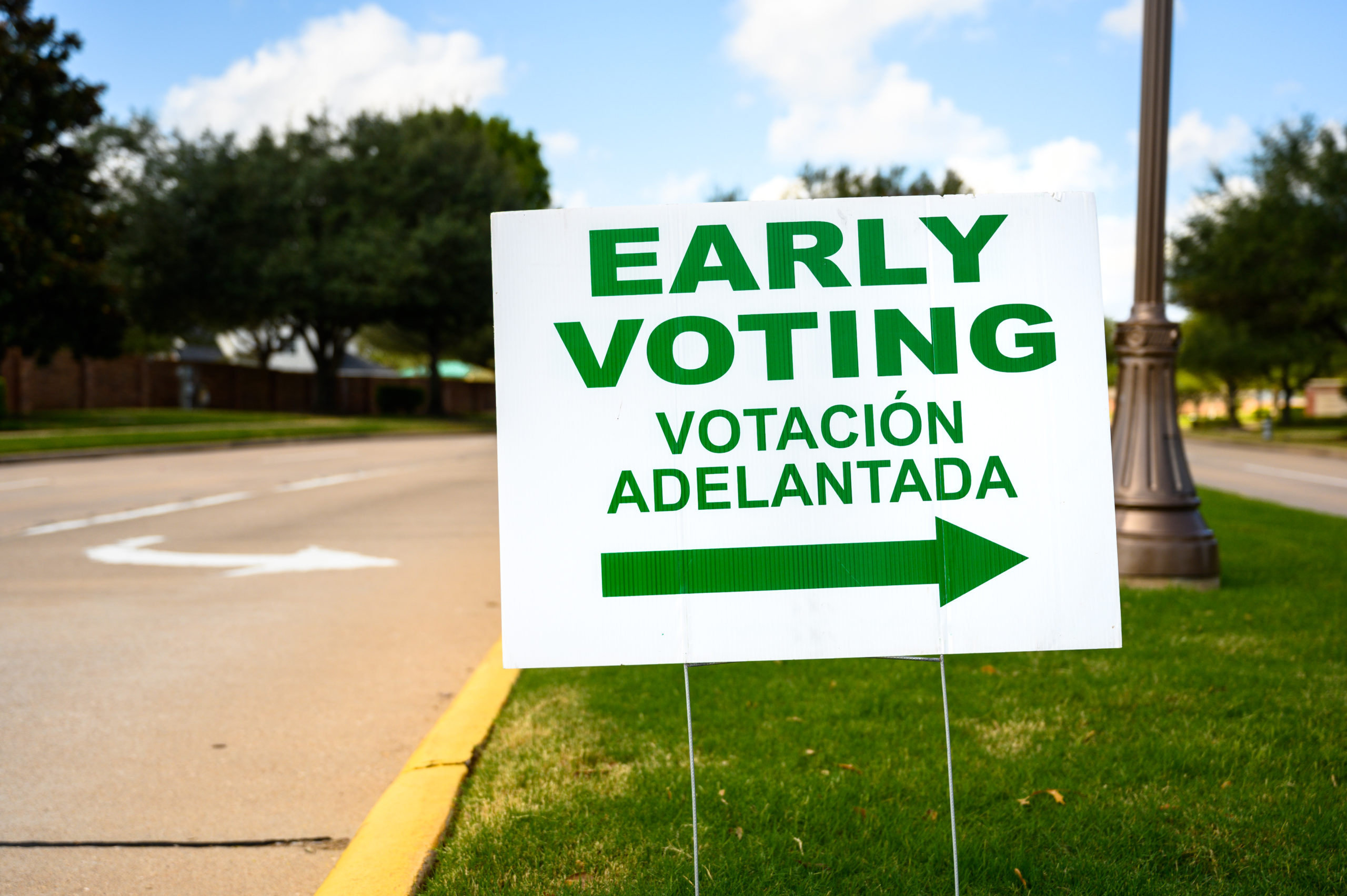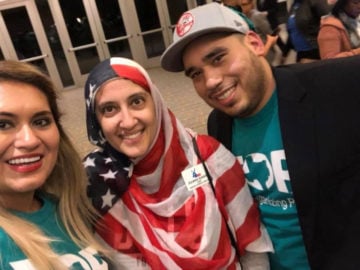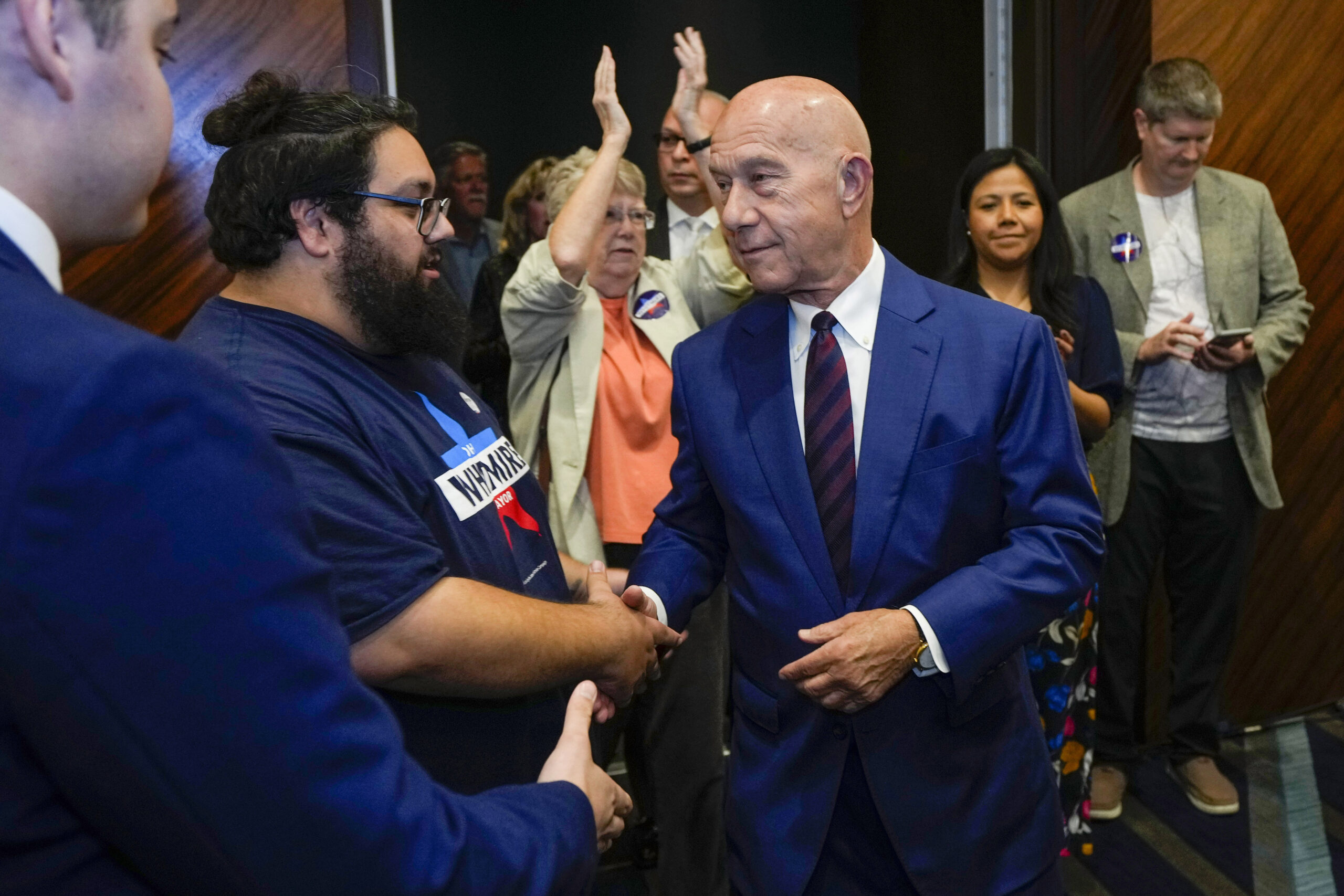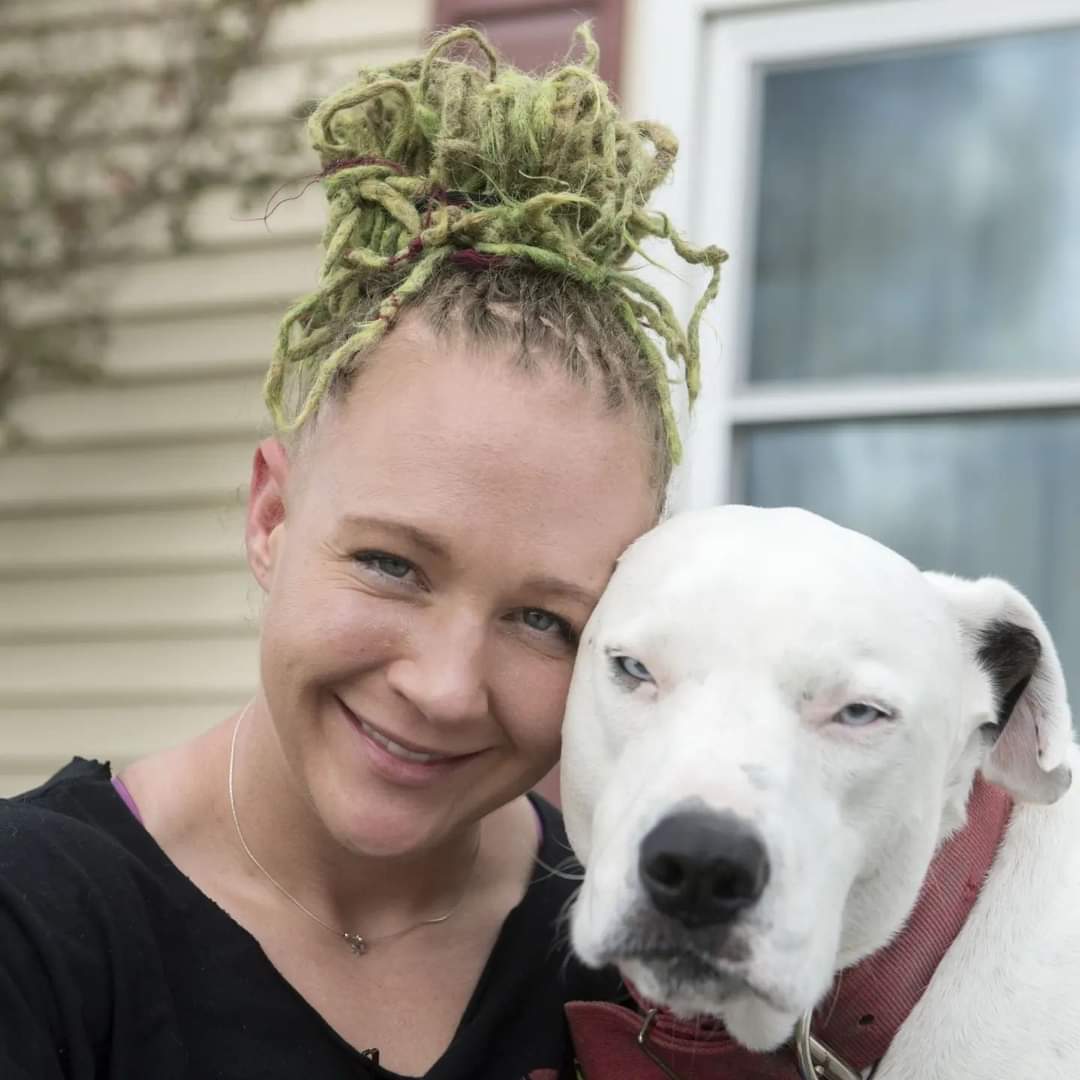
The Latino Vote And Its Legacy
For Latinos, casting a ballot means overcoming a history of struggle against exclusion and voter suppression.

This story was originally published by palabra.
Editor’s Note: At the start of 2020, palabra. posted a landmark essay by Michelle García that explored the state of play for Latinos in this important political year. We published a few weeks before the U.S. Centers for Disease Control and Prevention warned that our lives would be severely altered by a new coronavirus. The year has since become a tragic mess. Yet here we are, already voting in record numbers ahead of election day.
To mark the run-up to November 3, palabra. will explore the Latino vote: who’s making waves in the community, and what it took to get us to the point where we’re likely to play a decisive role in selecting the next U.S. president.
We start with this new essay by García—a look at the legacy of racism and oppression that’s fueled the surging will of Latinos to vote.
—Ricardo Sandoval-Palos, palabra. managing editor
In 2018, at an election night watch party in Austin, students and political junkies huddled around patio tables under the night sky, watching results flash across an oversized screen. It would be a historic night with record-breaking voter turnout. For some, their votes that day were invested with legacy—products of a struggle that exacted blood and sweat, and channeled a history of perseverance.
A Latino elder explained his passion for politics by describing making sandwiches when he was just waist-high for his parents’ union meetings where he witnessed power and community coming together. A sense of legacy was also with Aireka Sadler, a student at Huston-Tillotson University, a historically Black university in Austin, as she solemnly recounted marching to the polls that morning with her campus NAACP group, upholding a civil rights era tradition from the days when Blacks were often violently turned away.
Also that night, in Dallas, David Villalobos watched the returns with a team of volunteers after leading a last-minute push to get out the vote. It was a night linked to the memory of his 7-year-old self back in Laredo, when he joined his mother to campaign for a local candidate.
More than just memories, these experiences located their votes within a larger narrative, providing a context that infused their participation with historical significance. When Sadler described marching to the polls, it invoked a recognizable history of the Black struggle for racial democracy and equality of which she is beneficiary and heir. Her ballot represented the righting of a wrong. When congressional representatives donned all-white to commemorate the 19th Amendment, which extended the vote to white women in 1920, they acknowledged a long movement for the rights of women.
A long struggle to vote
For Latinos, though, there are no parallel iconic images or recognizable leaders that symbolize their struggle to secure the vote. But there has been a fight. With Latinos poised to become the second-largest voting bloc this year, understanding that fight explains the momentous effort to overcome obstacles to reach the ballot box—obstacles that are reminiscent of efforts to block Latino voters 50 years ago.
Knowing that legacy is why some people will stand in lines for up to nine hours at the polls, and why they persist when officials erect ever more obstacles between them and the ballot box. Knowing that history has armed young Latinos with the tools to assert their political power after decades of neglect. In this election, it is clear that Latinos are making history.
Without an understanding of the legacy Latinos built, the meaning of their vote is easily reducible to a candidate’s strategic interests, making Latinos ancillary factors in an electoral calculus. The diversity of Latinos nationwide is then distilled, for example, to the swing state of Florida.
When Latino diversity is explored, it’s often to focus on the absence of an easily digestible definition of Latino, a multitude that mostly identifies by country or heritage, according to the Pew Research Center.
What, then, is a California Chicano to a Florida Colombian American? What affinity exists between a Texas Mexican American AND a New York Puerto Rican? As journalist Graciela Mochkofsky writes in the New Yorker, the common thread among Latinos is “the ways in which they’ve been discriminated against by the white majority in this country.”
To reach the ballot box, Latinos have confronted suppression tactics from poll taxes to white-only primaries to violence, and have devised tactics to prevail over them. In the 1930s, Magdalena Carrasquillo, newly arrived in New York from Puerto Rico, confronted an English-only literacy test at her polling site. But nearby she encountered a neighborhood matron who prepared Puerto Ricans for the test, and with her help, she returned and cast her ballot.
Such tests were common in places like Arizona. Texas lawmakers went further in 1918, making interpreters at the polls illegal. The common cause of discrimination led to court battles in the 1960s waged by Puerto Ricans in New York against those literacy tests and legal challenges by Mexican Americans in Texas to force an acknowledgment of racial discrimination beyond the nation’s Black and white binary.
Laws to end discrimination and intimidation
With the 1965 Civil Rights Act, a defining achievement of the African American civil rights struggle, came the dismantling of voter discrimination and the addition of safeguards to prevent states from adopting suppression tactics in the future. But for most Latinos, access to the ballot didn’t occur for another decade, with the Voting Rights Act of 1975, when civil rights law was extended to Latinos, Asians, Native Americans and other “language minorities.”
“We have to recognize we were able to vote in large part because of the African American community,” says Maria Teresa Kumar, cofounder of Voto Latino. “We were also fighting alongside them, and that story is often not shared.”
In 1977, Texas challenged its inclusion in the Voting Rights Act. In an opinion upholding voter protections for Latinos, U.S. Supreme Court Justice Thurgood Marshall wrote that they faced voter discrimination that was “pervasive and national in scope” and “aggravated by acts of physical, economic, and political intimidation.”
“We have to recognize we were able to vote in large part because of the African American community. We were also fighting alongside them, and that story is often not shared.”
Such discrimination, Marshall wrote, was “an insidious and pervasive evil.”
That evil persisted for decades. In the 1980s, Latinos in New Jersey were targeted for intimidation by off-duty law enforcement officers hired by the Republican Party as poll watchers. In response, a federal consent decree governed how poll watchers operated. It expired in 2018, making the 2020 election the first presidential election without those protections.
“There’s no single Latino story about the relationship of citizens and the state when it comes to elected power,” said Frances Negrón-Muntaner, associate professor at Columbia University and founding director of the Media and Idea Lab and the Latino Arts and Activism Archive. “There are multiple stories.”
“There’s no single Latino story about the relationship of citizens and the state when it comes to elected power. There are multiple stories.”
In 2013, the Supreme Court gutted the voting rights protections in Shelby County v. Holder, unleashing a wave of voter suppression efforts by states that tend to benefit the governing Republican Party. Arizona and Texas adopted voter ID laws that, in the case of Texas, potentially disenfranchised some 600,000 mostly Black and Latino voters. Last year, Texas attempted to purge voting rolls of 90,000 naturalized, mostly Latino, registered voters, while lawmakers have designed legislative maps to dilute Latino voter influence. Nationally, the wait time to cast a ballot for Latinos is twice as long as it is for whites.
A dual threat to the Latino vote
Nowhere is the ethnic thread of discrimination more evident than in simultaneous crises confronting Latinos: rampant confusion about casting a ballot in a pandemic, even as they deal with the coronavirus’ devastating economic and human toll. At least 36,500 Latinos have succumbed to COVID-19, according to an analysis by the Washington Post, and the community has suffered soaring unemployment and widespread financial ruin.
Several Latino groups have sounded the alarm about the multiple obstacles to voting, now compounded with mass confusion over voting procedures during the pandemic. Nearly one-third of Latinos report they are unsure of the mail-in ballot process, reports the polling firm Latino Decisions. Some 75 percent of Latino voters told the voting rights group Voto Latino they were concerned about their vote, with 59 percent saying they had never voted by mail. Even more, reports have surfaced of Spanish-speaking voters feeling intimidated by poll watchers.
Such obstacles could shut out the very group that has been among the hardest hit by the pandemic. Latinos are 2.8 times more likely to become infected with the virus than white people, higher than any other group, according to recent data by the Centers for Disease Control and Prevention.
“The moral debt is what is happening right now,” said Maria Teresa Kumar, cofounder of Voto Latino, citing the soaring mental health crisis following the pandemic and in response to the Trump administration’s ongoing assault on Latinos. In response to the political climate, young Latinos tell pollsters racial injustice is a primary driver to their vote, with 82 percent attributing motivation to the Black Lives Matter protests.
Demanding results
But voting itself, or even a sense of the historical weight of an individual’s vote, as organizers will say, only goes so far: Eligible voters who have never known a political system that addresses their needs want results and representation.

When David Villalobos arrived in San Antonio from his native Laredo, he landed with an idealistic vision of a powerful vote. But that changed after he went into the city’s working-class westside and tried to convince an elderly woman that her vote mattered. She talked about robberies, lack of public services, and neglect. “I couldn’t look into her eyes and say that voting wasn’t going to change it,” said Villalobos, the Right2Justice coordinator for the Texas Organizing Project. “In order to get someone to believe the system we have to organize with this person and show them and what the power of community feels like.” He had to return with the receipts that showed change.
“In order to get someone to believe the system we have to organize with this person and show them and what the power of community feels like.”
Going into the 2020 Election, Latinos have seized on historical legacy to learn from the past, drawing from strategies that reflect the diversity of geographical and life experiences.
In Arizona, Latinos address decades of anti-Latino sentiment that has resulted in harsh law enforcement and voter laws BY tracing its origins to receding activism and neglect by Democrats after the era of literacy tests. “They didn’t see us as necessary to any election victory, then left us vulnerable to attacks and marginalization,” said Alejandra Gomez, co-director of Living United for Change in Arizona (LUCHA), a grassroots organization created to build political power among working-class families.
In response, Latino leaders formulated a political agenda that reflected the community’s needs and, more importantly, voted for leaders who reflected their values. It is reminiscent of the political mobilization in California that followed a series of harsh anti-immigrant laws and reshaped the state’s political landscape.
Their strategy contains echoes of the New York Puerto Rican militant advocacy group the Young Lords. “Votes are an abstract right, everyone has one vote,” said journalist Juan Gonzalez, the group’s minister of defense in 1971. “But once again, Nelson Rockefeller’s vote is worth a whole lot more than your or my vote … he chooses the people we’re going to vote for.”
In North Carolina, four Latino groups launched a voter registration drive with postcards featuring beloved pop culture icon Walter Mercado. Among them is Poder NC, a pro-Black, pro-LGBTQ Latinx advocacy group founded in 2019 — meaning this will be their first presidential election. The founder, Irene Godínez, is the daughter of Mexican farmworkers but doesn’t look to the civil rights icon César Chávez for inspiration. Instead, she draws from the diverse threads closer to home: She quotes James Baldwin. And she finds inspiration from the justice movement for Mexico’s disappeared and the legacy of the Black civil rights movement. North Carolina’s state motto is tattooed to her wrist: Esse Quam Videri, or “To Be Rather Than To Seem.”
Recently, the Latino pop culture site Remezcla launched Tejas Made, a 12-part multimedia project spanning everything from climate change to the love for big pickup trucks to Election 2020. It focuses on “past, present and possible futures.” It was a response, says Remezcla’s Itzel Alejandra Martinez, to a study by the Texas-based Jolt Institute, which grooms Latinx youth for political leadership and mobilizes voters, that found young Texas Latinos feel alienated from the political process and are searching for a political identity.
“One of the most important things that Latinos have contributed has been political imagination,” Negrón-Muntaner says. “It’s about making a leap between what is and what should be and why.”
Read more from the Observer:
-
The Forgotten Children of Texas: Each year, thousands of foster children in Texas are shuffled into little-known “treatment centers” where they are frequently neglected and abused. State officials have largely ignored allegations of wrongdoing and calls for reform.
-
The Long Tail of Voter Suppression: As the growing number of Black and Latinx voters threaten the GOP’s stranglehold on power, attempts to limit safe voting options during the pandemic reveal a deeper sickness in Texas politics.
-
If Not Now, When? Dems’ Fight for the House Will Shape Texas Politics for Years: Democrats hope to end nearly 20 years of GOP dominance in the state government.


